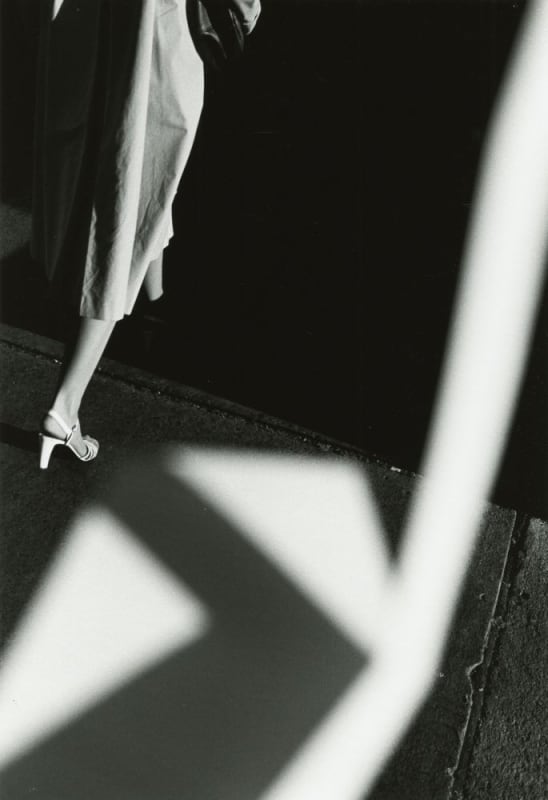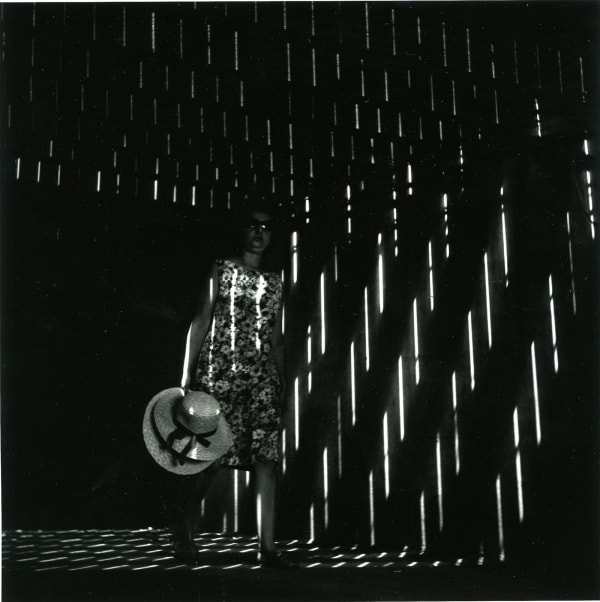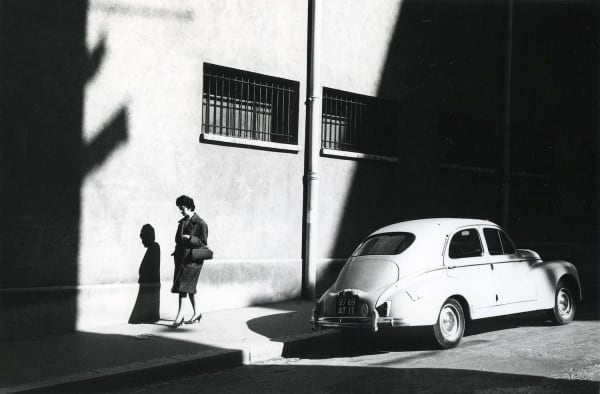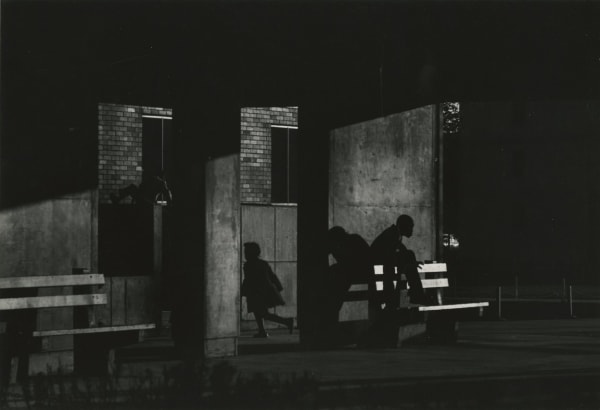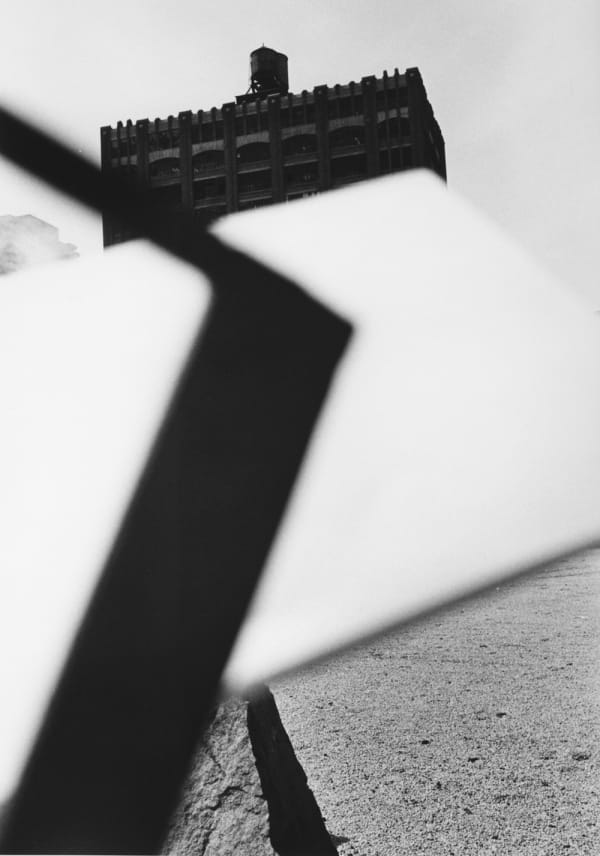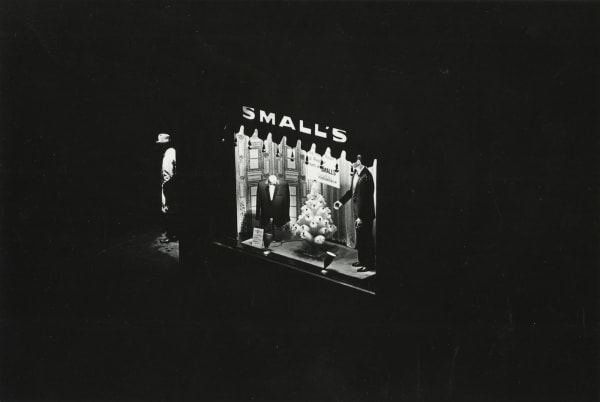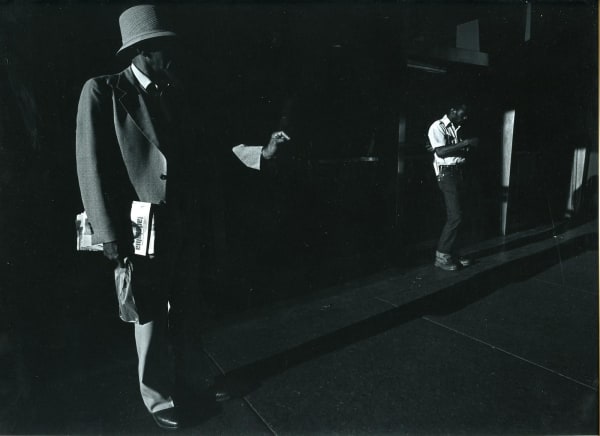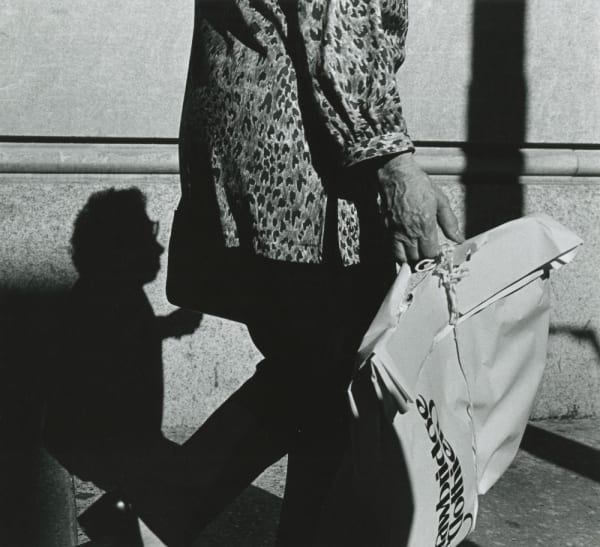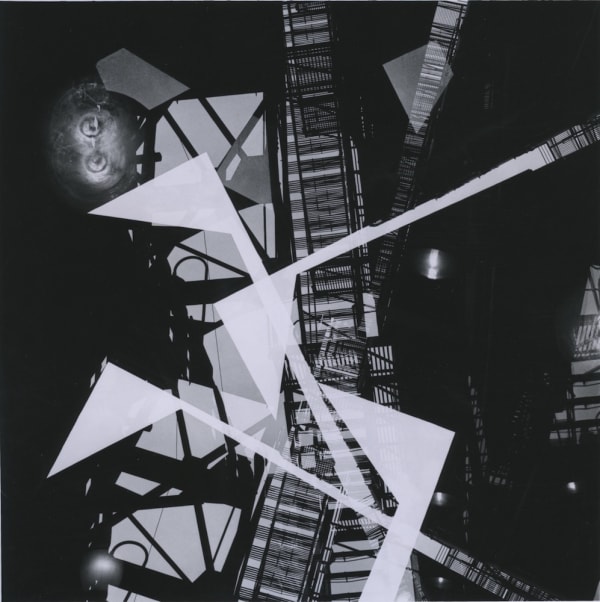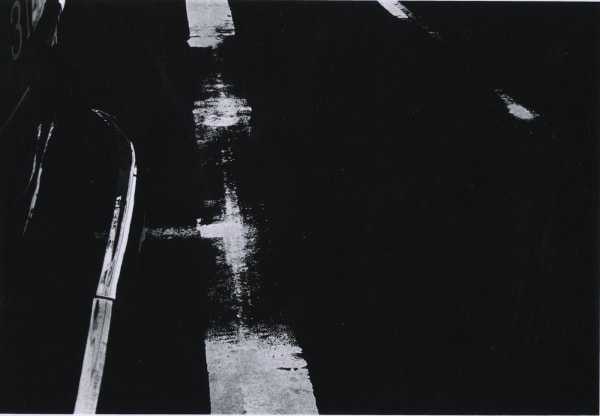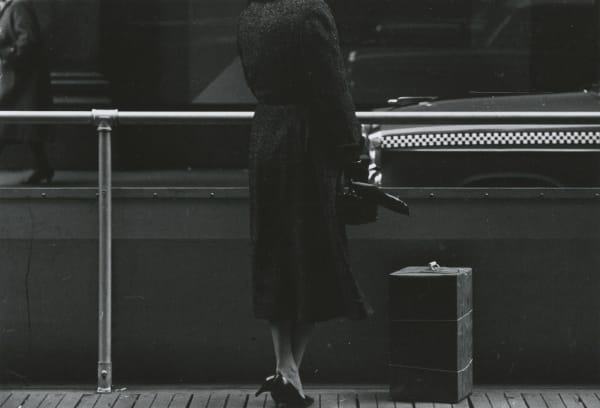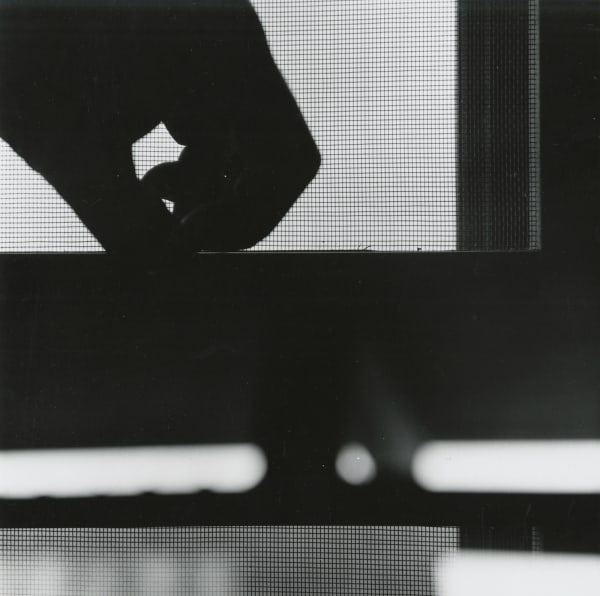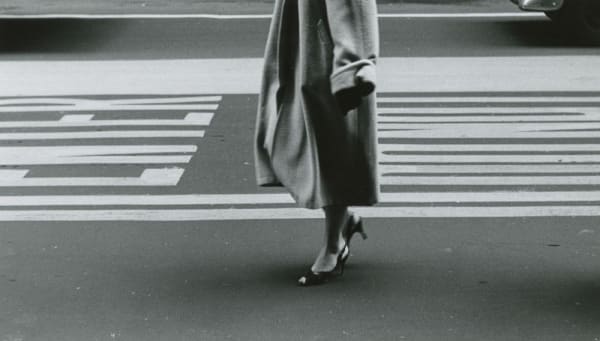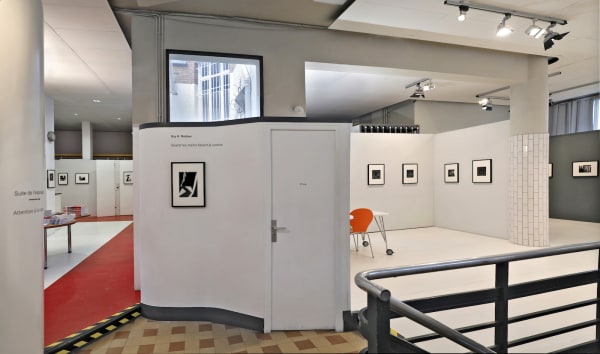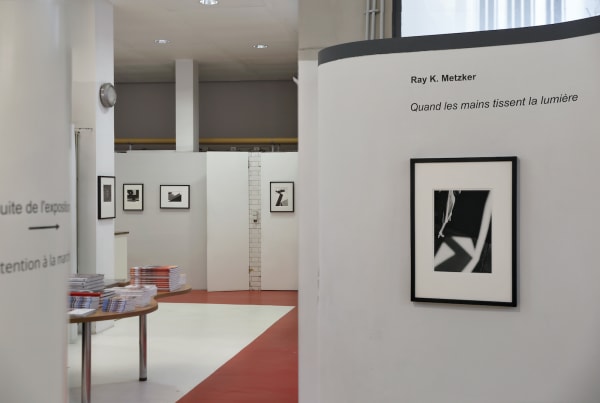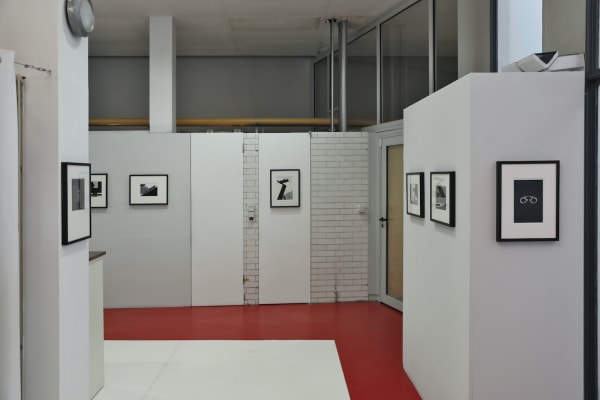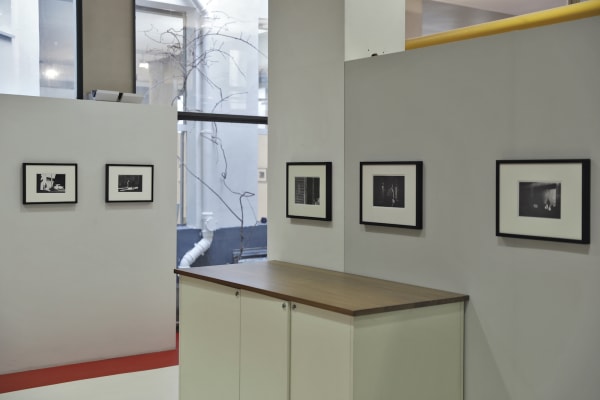Ray K. Metzker, When hands weave the light
Les Douches la Galerie is pleased to present When hands weave the light, our second exhibition dedicated to the work of Ray K. Metzker. Composed of some fifty prints taken from various series, this exhibition highlights his sustained interest in experimentation. A virtuoso of light and absolute master of his prints, Metzker pushes the formal boundaries of the photographic medium as well as those of American urban space. These photographs, taken between 1957 and 1982, offer a unique visual journey through the streets of Chicago, Philadelphia, Atlantic City and several European cities.
Extended until September 19th, 2020
Summer break from August 1st to September 1st
-
 Ray K. MetzkerChicagoTirage gélatino-argentique d'époque, réalisé par l'artiste18,3 x 18,4 cm
Ray K. MetzkerChicagoTirage gélatino-argentique d'époque, réalisé par l'artiste18,3 x 18,4 cm
Dim. papier: 20,2 x 25,2 cm -
 Ray K. MetzkerUnder the boardwalk, Atlantic CityTirage gélatino-argentique postérieur, réalisé par l'artiste20,2 x 20,2 cm
Ray K. MetzkerUnder the boardwalk, Atlantic CityTirage gélatino-argentique postérieur, réalisé par l'artiste20,2 x 20,2 cm
Dim. papier: 35,5 x 27,6 cm -
 Ray K. Metzker, Europe, Marseille, France, 1961
Ray K. Metzker, Europe, Marseille, France, 1961 -
 Ray K. Metzker, Philadelphia, 1963
Ray K. Metzker, Philadelphia, 1963
-
 Ray K. Metzker, Early Philadelphia, 1962
Ray K. Metzker, Early Philadelphia, 1962 -
 Ray K. Metzker, Chicago - Non Loop, 1958
Ray K. Metzker, Chicago - Non Loop, 1958 -
 Ray K. MetzkerPictus Interruptus, New York CityTirage gélatino-argentique d'époque, réalisé par l'artiste19,7 x 28 cm
Ray K. MetzkerPictus Interruptus, New York CityTirage gélatino-argentique d'époque, réalisé par l'artiste19,7 x 28 cm
Dim. papier: 35 x 28 cm -
 Ray K. MetzkerCity Whispers, PhiladelphiaTirage gélatino-argentique postérieur, réalisé par l'artiste20,5 x 28,6 cm
Ray K. MetzkerCity Whispers, PhiladelphiaTirage gélatino-argentique postérieur, réalisé par l'artiste20,5 x 28,6 cm
Dim. papier: 28 x 35 cm
-
 Ray K. Metzker, City Whispers, Philadelphia, 1982
Ray K. Metzker, City Whispers, Philadelphia, 1982 -
 Ray K. MetzkerEarly PhiladelphiaTirage gélatino-argentique d'époque, réalisé par l'artiste14,8 x 22 cm
Ray K. MetzkerEarly PhiladelphiaTirage gélatino-argentique d'époque, réalisé par l'artiste14,8 x 22 cm
Dim. papier: 20,2 x 25,3 cm -
 Ray K. Metzker, Early Philadelphia, 1964
Ray K. Metzker, Early Philadelphia, 1964 -
 Ray K. MetzkerCity Whispers, PhiladelphiaTirage gélatino-argentique d'époque, réalisé par l'artiste30,3 x 22 cm
Ray K. MetzkerCity Whispers, PhiladelphiaTirage gélatino-argentique d'époque, réalisé par l'artiste30,3 x 22 cm
Dim. papier: 35,4 x 27,5 cm
-
 Ray K. MetzkerCity Whispers, PhiladelphiaTirage gélatino-argentique d'époque, réalisé par l'artiste21 x 29,7 cm
Ray K. MetzkerCity Whispers, PhiladelphiaTirage gélatino-argentique d'époque, réalisé par l'artiste21 x 29,7 cm
8.27 x 11.42 in
Dim. papier: 27,6 x 35,5 cm -
 Ray K. Metzker, City Whispers, Philadelphia, 1981
Ray K. Metzker, City Whispers, Philadelphia, 1981 -
 Ray K. MetzkerCity Whispers, PhiladelphiaTirage gélatino-argentique d'époque, réalisé par l'artiste18,6 x 13,5 cm
Ray K. MetzkerCity Whispers, PhiladelphiaTirage gélatino-argentique d'époque, réalisé par l'artiste18,6 x 13,5 cm
Dim. papier: 25,2 x 20,3 cm -
 Ray K. MetzkerCouplets, New YorkTirage gélatino-argentique d'époque, réalisé par l'artiste22,7 x 15,5 cm
Ray K. MetzkerCouplets, New YorkTirage gélatino-argentique d'époque, réalisé par l'artiste22,7 x 15,5 cm
Dim. papier: 25,4 x 20,4 cm
-
 Ray K. MetzkerValencia, SpainTirage gélatino-argentique d'époque, réalisé par l'artiste21,5 x 14 cm
Ray K. MetzkerValencia, SpainTirage gélatino-argentique d'époque, réalisé par l'artiste21,5 x 14 cm
Dim. papier: 24,7 x 20,2 cm -
 Ray K. MetzkerChicago - LoopTirage gélatino-argentique d'époque, réalisé par l'artiste18 x 18 cm
Ray K. MetzkerChicago - LoopTirage gélatino-argentique d'époque, réalisé par l'artiste18 x 18 cm
Dim. papier: 20,3 x 25,4 cm -
 Ray K. MetzkerUnder the boardwalk, Atlantic CityTirage gélatino-argentique postérieur, réalisé par l'artiste15,2 x 15,2 cm
Ray K. MetzkerUnder the boardwalk, Atlantic CityTirage gélatino-argentique postérieur, réalisé par l'artiste15,2 x 15,2 cm
Dim. papier: 20,3 x 25,4 cm -
 Ray K. MetzkerPhiladelphiaTirage gélatino-argentique d'époque, réalisé par l'artiste15,3 x 22,3 cm
Ray K. MetzkerPhiladelphiaTirage gélatino-argentique d'époque, réalisé par l'artiste15,3 x 22,3 cm
Dim. papier: 20,2 x 25,4 cm
-
 Ray K. MetzkerUnder the Boardwalk, Atlantic CityTirage gélatino-argentique postérieur, réalisé par l'artiste17,5 x 17,7 cm
Ray K. MetzkerUnder the Boardwalk, Atlantic CityTirage gélatino-argentique postérieur, réalisé par l'artiste17,5 x 17,7 cm
6.69 x 6.69 in
Dim. papier: 20,2 x 25,4 cm -
 Ray K. MetzkerPhiladelphiaTirage gélatino-argentique postérieur, réalisé par l'artiste15,4 x 22,8 cm
Ray K. MetzkerPhiladelphiaTirage gélatino-argentique postérieur, réalisé par l'artiste15,4 x 22,8 cm
Dim. papier: 17,4 x 25,4 cm -
 Ray K. MetzkerCity Whispers, PhiladelphiaTirage gélatino-argentique postérieur, réalisé par l'artiste30,6 x 17,2 cm
Ray K. MetzkerCity Whispers, PhiladelphiaTirage gélatino-argentique postérieur, réalisé par l'artiste30,6 x 17,2 cm
Dim. papier: 35,4 x 27,7 cm -
 Ray K. Metzker, Early Philadelphia, 1968
Ray K. Metzker, Early Philadelphia, 1968
-
 Ray K. Metzker, Chicago - Loop, 1957
Ray K. Metzker, Chicago - Loop, 1957 -
 Ray K. Metzker, Chicago - Non Loop, 1957
Ray K. Metzker, Chicago - Non Loop, 1957 -
 Ray K. Metzker, City Whispers, Philadelphia, 1981
Ray K. Metzker, City Whispers, Philadelphia, 1981 -
 Ray K. MetzkerPhiladelphiaTirage gélatino-argentique d'époque, réalisé par l'artiste19,6 x 13,9 cm
Ray K. MetzkerPhiladelphiaTirage gélatino-argentique d'époque, réalisé par l'artiste19,6 x 13,9 cm
Dim. papier: 25,2 x 20,2 cm
-
 Ray K. MetzkerChicagoTirage gélatino-argentique d'époque, réalisé par l'artiste21,7 x 12,9 cm
Ray K. MetzkerChicagoTirage gélatino-argentique d'époque, réalisé par l'artiste21,7 x 12,9 cm
Dim. papier: 25,3 x 20,4 cm -
 Ray K. MetzkerChicagoTirage gélatino-argentique d'époque, réalisé par l'artiste18,7 x 18,7 cm
Ray K. MetzkerChicagoTirage gélatino-argentique d'époque, réalisé par l'artiste18,7 x 18,7 cm
Dim. papier: 20,2 x 25,4 cm -
 Ray K. Metzker, City Whispers, 1980
Ray K. Metzker, City Whispers, 1980 -
 Ray K. MetzkerCity Whispers, PhiladelphiaTirage gélatino-argentique d'époque, réalisé par l'artiste17,8 x 13,8 cm
Ray K. MetzkerCity Whispers, PhiladelphiaTirage gélatino-argentique d'époque, réalisé par l'artiste17,8 x 13,8 cm
Dim. papier: 25,4 x 20,4 cm
-
 Ray K. MetzkerPhiladelphiaTirage gélatino-argentique d'époque, réalisé par l'artiste22,2 x 13,9 cm
Ray K. MetzkerPhiladelphiaTirage gélatino-argentique d'époque, réalisé par l'artiste22,2 x 13,9 cm
Dim. papier: 25,2 x 20,1 cm -
 Ray K. Metzker, City Whispers, 1982
Ray K. Metzker, City Whispers, 1982 -
 Ray K. MetzkerCity WhispersTirage gélatino-argentique postérieur, réalisé par l'artiste20,5 x 30,2 cm
Ray K. MetzkerCity WhispersTirage gélatino-argentique postérieur, réalisé par l'artiste20,5 x 30,2 cm
7.87 x 11.81 in
Dim. papier: 27,8 x 35,5 -
 Ray K. MetzkerPhiladelphiaTirage gélatino-argentique d'époque, réalisé par l'artiste15,3 x 22,5 cm
Ray K. MetzkerPhiladelphiaTirage gélatino-argentique d'époque, réalisé par l'artiste15,3 x 22,5 cm
Dim. papier: 20 x 25,2 cm
-
 Ray K. MetzkerEuropeTirage gélatino-argentique d'époque, réalisé par l'artiste15,4 x 21,6 cm
Ray K. MetzkerEuropeTirage gélatino-argentique d'époque, réalisé par l'artiste15,4 x 21,6 cm
Dim. papier: 17,9 x 23,8 cm -
 Ray K. MetzkerAlicante, SpainTirage gélatino-argentique postérieur, réalisé par l'artiste15 x 23,5 cm
Ray K. MetzkerAlicante, SpainTirage gélatino-argentique postérieur, réalisé par l'artiste15 x 23,5 cm
Dim. papier: 20 x 25,4 cm -
 Ray K. MetzkerEarly PhiladelphiaTirage gélatino-argentique d'époque, réalisé par l'artiste15 x 22,1 cm
Ray K. MetzkerEarly PhiladelphiaTirage gélatino-argentique d'époque, réalisé par l'artiste15 x 22,1 cm
Dim. papier: 20,2 x 25,3 cm -
 Ray K. MetzkerPhiladelphiaTirage gélatino-argentique postérieur, réalisé par l'artiste15,2 x 22,2 cm
Ray K. MetzkerPhiladelphiaTirage gélatino-argentique postérieur, réalisé par l'artiste15,2 x 22,2 cm
Dim. papier: 16,8 x 24,2 cm
-
 Ray K. MetzkerAlbuquerque, New MexicoTirage gélatino-argentique d'époque, réalisé par l'artiste17 x 21,5 cm
Ray K. MetzkerAlbuquerque, New MexicoTirage gélatino-argentique d'époque, réalisé par l'artiste17 x 21,5 cm
Dim. papier: 27,8 x 35,5 cm -
 Ray K. MetzkerUnder the boardwalk, Atlantic CityTirage gélatino-argentique postérieur, réalisé par l'artiste22,6 x 22 cm
Ray K. MetzkerUnder the boardwalk, Atlantic CityTirage gélatino-argentique postérieur, réalisé par l'artiste22,6 x 22 cm
Dim. papier: 35,5 x 28,7 cm -
 Ray K. MetzkerPhiladelphiaTirage gélatino-argentique d'époque, réalisé par l'artiste13,4 x 22,4 cm
Ray K. MetzkerPhiladelphiaTirage gélatino-argentique d'époque, réalisé par l'artiste13,4 x 22,4 cm
Dim. papier: 20 x 25 cm -
 Ray K. MetzkerChicagoTirage gélatino-argentique d'époque, réalisé par l'artiste19,4 x 19,1 cm
Ray K. MetzkerChicagoTirage gélatino-argentique d'époque, réalisé par l'artiste19,4 x 19,1 cm
Dim. papier: 25,3 x 20,3 cm
-

3 expositions photo à voir à Paris cette semaine
Claire Beghin, Vogue, 16 June 2020 -

Ray K. Metzker, un photographe à l'école de la rue
Frédérique Chapuis, Télérama, 3 June 2020 This link opens in a new tab. -

Ray K. Metzker
Etienne Hatt, Artpress, 2 June 2020 This link opens in a new tab. -
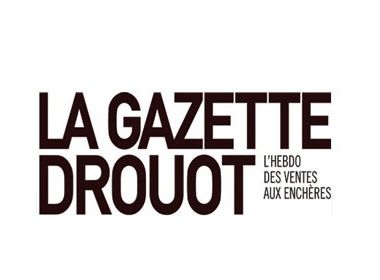
Ray K. Metzker, Quand les mains tissent la lumière
Sophie Bernard, La Gazette Drouot, 1 June 2020
-

Ray K. Metzker, Quand les mains tissent la lumière
Frédérique Chapuis, Télérama, 1 June 2020 This link opens in a new tab. -

Sélection galeries : Vincent Bioulès à La Forest Divonne, Philip-Lorca diCorcia chez David Zwirner et Ray Metzker aux Do
Claire Guillot, Le Monde, 29 May 2020 -
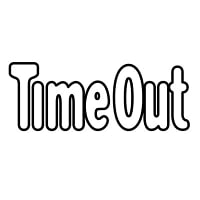
Quand les mains tissent la lumi?re
Rémi Morvan, Time Out, 28 May 2020 -
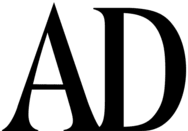
10 expositions en galerie à voir à Paris
Marina Hemonet, AD Magazine, 26 May 2020
-

La photographie se déconfine : galeries, fondations, les lieux qui ont rouvert ou rouvrent bientôt à Paris
Valérie Oddos, France Info, 22 May 2020 -

Focus Ray K. Metzker - Les Douches la Galerie
Guillaume Benoit, Slash, 5 May 2020 -
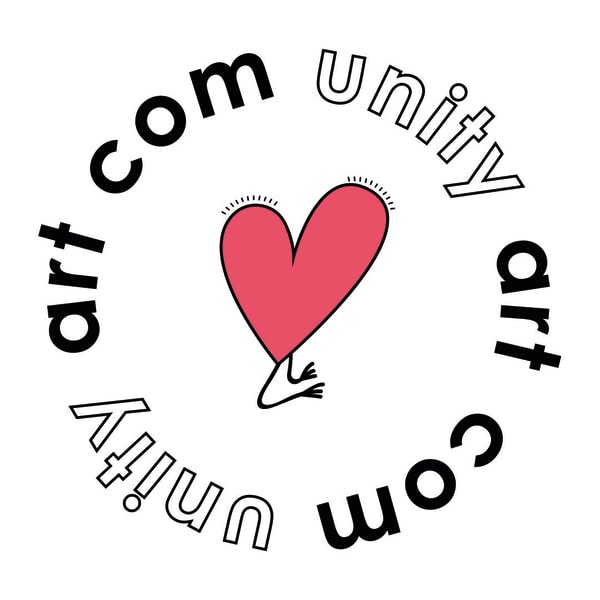
La photographie à l'honneur
Com Unity Art, 15 April 2020 -
En avril, des expos photos à portée de clic
Laure Étienne, Polka Magazine, 13 April 2020
In twenty-five years, Ray Metzker has produced more than a dozen series of photographs, each series radically different from the others. He has steadily sought new vision, asking, ?Why does new vision matter? Do I need this? Does it increase my capacity to care? No, but it increases my capacity to think.? For Metzker, the struggle for new vision is an act against inertia and stillness and toward intensity and knowledge. (...)
Each new series of photographs begins with a change in his preoccupations about photography or with a change in what ? or where ? he is photographing. He opens himself to new experience and watches his ideas emerge and develop. He has said, ?At that time I am scanning or simply looking. When I realize there are certain stimuli that I keep responding to, that reoccur in my perceptual field, then I can begin to identify a pattern.? These new constants become what he calls his ?terms?, which are the contractual arrangements he makes with himself about an emerging series of pictures. The ?terms? are both points of departure and the rules that discipline his work. They are both limiting and liberating, allowing him license to explore within their confines and to push until the terms are exhausted. (...)
This working process evolved during Metzker?s first major project, My Camera and I in the Loop, 1957-1958, which was his graduate thesis at the Institute of Design in Chicago. Metzker?s initial ?term? for The Loop was the physical boundary formed by Chicago?s elevated railway, which encircles downtown. As Metzker photographed, he realized that the project was also about formal limitations: the relationship between his camera and himself, and his search for significant form, which took precedence over the objects yielding the forms. Using a Leica (with 35mm, 50mm, and 135mm lenses) and a Rolleiflex, he made images that explore motion blur, depth of field, vantage point, frame, focus, and back lighting, a sampling of the in-depth explorations that later work would compass. (...)
Beginning with The Loop, Metzker looked to street activity for what he calls ?events.? ?I would see those relationships developing, and I would feel something fall into place,? he says. ?It wasn?t that I came up to something and said, isn?t that a nice arrangement? It was a sense of the tension, of knowing that these things were moving, and also that they had come into a position where the tensions were right and that was it. After a while it could happen simply with light.(...)
When Metzker traveled in Europe in 1960-1961, he mastered his skill of composing with highlights and heightened his sensitivity to lyric sweetness in human gestures. In his view, Europeans are unhurried; they converse, touch, and appear to integrate with their surroundings rather than pass through them in the preoccupied isolation that characterizes the people in the Chicago series. (...)
When Metzker moved to Philadelphia in 1962, the dual enchantment of photographing people and of composing with highlights was refined into two distinct pursuits. (...) Also like The Loop pictures, the Philadelphia photographs were taken in a prescribed area, within walking distance of Metzker's apartment. (...)
Not wanting to describe his downtown neighborhood, he took graphic delight in its details: signage, wrought iron façades, street lamps, and pavement markings. In these widely published images from Philadelphia, people are either excluded or seen only in silhouette. The most striking aspect of these pictures is the economy of the compositions. They reach a simplicity and directness that Metzker regards as a climax in his pursuit of minimal but evocative spaces. (...)
Impermanence and flux are also expressed in his pictures as fragments: a face or arm disembodied in shadows, lights floating free of a building, a figure dissected by venetian blinds. Metzker acknowledges that fragmentation is a means of transforming an event to achieve a personal synthesis. ?You have to break something down,? he has said, ?in order to have the parts to synthesize. If something?s complete, there is no need to synthesize ? it?s complete, finished. In journalism, the photograph is of an event, whereas in my later work, the photograph is the event.? (?)
There are also ideas that Metzker carries from the studio to the street. The studio work of the mid-1970s culminated with the series Pictus Interruptus, 1976-1980. For Pictus, he fashioned objects in the studio to be included in photographs made outside. He held small objects directly in front of the camera lens, partially obscuring the scene beyond the object.
Extending the predominance of light over dark tones which began in New Mexico, the images of Pictus are composed of angular black occluding devices held against hard white planes or of winding white shapes on light gray fields. (...) The Pictus photographs are breathtaking in their originality and disjunctive associations. They are haunting and indecipherable. (...)
In Metzker?s most recent series, City Whispers, people are isolated, fragmented, and often faceless. While his cities are neither inviting nor kind, the streets are jumpy with bright lights and movement in a lively play of highlights, shadows, and reflections that contradicts the weight of human isolation, of beings alone in a huge dark universe. The bittersweet pain in the pictures is made palpable through the elegance of its expression.
This recent work incorporates ideas and pictorial devices from previous series without establishing elaborate, technical terms. He achieves, in single-negative format, graphic events first realized in multiple-negative compositions. The spatial ambiguities created by abutting two negatives in Double Frame are brought about now with shadows and shafts of light. The fragmentation achieved by overlapping negatives in Composites is accomplished in City Whispers by photographing naturally overlapping shapes. As in all of his previous work, the ?event? that he is photographing is light, but in City Whispers, he reaches new levels of synthesis and control of multilayered scenes.
